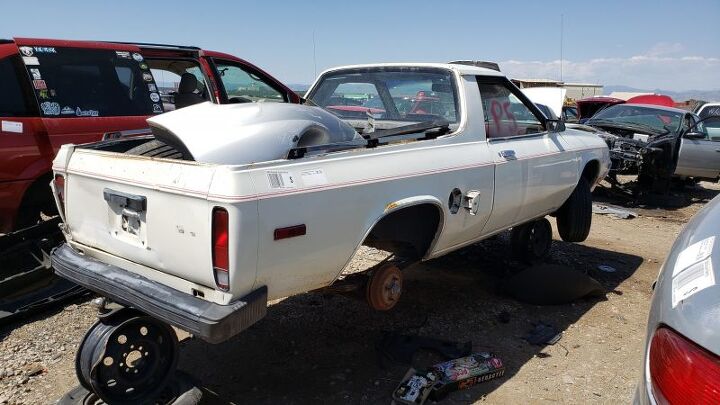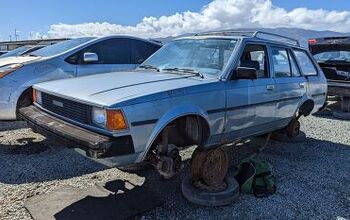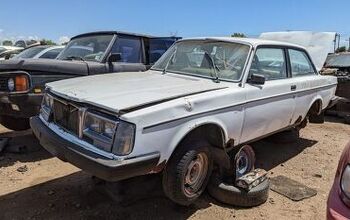Junkyard Find: 1983 Plymouth Scamp

North American sales of Japanese-made small pickups went crazy during the 1970s, with the Detroit Big Three getting in on the action with rebadged Mazdas, Isuzus, and Mitsubishis. Ford and GM eventually created their own Michigan-style small trucks, the Ranger (1983 model year) and S-10 (1982 model year) but where was struggling Chrysler— in a frenzy trying to get the new K-Cars out the door— supposed to find enough money to develop a new truck design from scratch? Fortunately, Volkswagen had shown that front-wheel-drive worked well enough in little pickups, and the versatile Omnirizon platform proved suitable for a bit of El Camino-ization. Here’s the result, found in a Denver yard last summer.
The Dodge Omni/Plymouth Horizon came out of a Chrysler Europe effort to build a VW Golf competitor, and the North American versions (which differed substantially from their Simca/ Talbot brethren) sold very well starting in the 1978 model year. Chrysler USA developed a wide range of cars from this L-Body platform, including the Dodge 024/ Plymouth TC3, 1983-1987 Dodge Charger, and the legendary “Cocaine Factory” Turismo Duster, even while K-based machinery rolled off assembly lines.
So, a Dodge Omni 024 with pickup bed and Rampage badges appeared in the 1982 model year, with production continuing through 1984. The Plymouth-badged version was called the Scamp (after the cheap-but-sporty hardtop version of the 1971-1976 Valiant), got the Turismo snout, and was sold in the 1983 model year alone.
Junkyard shoppers hit the interior of this one pretty hard before I got to it, but you can still admire the racy-looking two-tone driver’s seat.
Some other US-market L-bodies were still getting Volkswagen or Simca engines in 1983, but all Rampages and Scamps got the 2.2-liter four-banger Chrysler developed for the K-Cars. This one was rated at 85 horsepower, not much even for a 2,305-pound lightweight truck.
The base transmission was a four-speed manual; a five-speed manual and three-speed automatic were options. This cartruck has one of the manuals.
Because the original buyer sprang for both air conditioning and a four-speaker AM/FM radio, I feel fairly certain that the transmission has five forward gears.
Total Scamp sales came to just 3,564, so we’re looking at an extremely rare junkyard find.
At least one Scamp still survives as a race cartruck!
For links to 2,000+ additional Junkyard Finds, visit the Junkyard Home of the Murilee Martin Lifestyle Brand™.

Murilee Martin is the pen name of Phil Greden, a writer who has lived in Minnesota, California, Georgia and (now) Colorado. He has toiled at copywriting, technical writing, junkmail writing, fiction writing and now automotive writing. He has owned many terrible vehicles and some good ones. He spends a great deal of time in self-service junkyards. These days, he writes for publications including Autoweek, Autoblog, Hagerty, The Truth About Cars and Capital One.
More by Murilee Martin
Latest Car Reviews
Read moreLatest Product Reviews
Read moreRecent Comments
- W Conrad I'm not afraid of them, but they aren't needed for everyone or everywhere. Long haul and highway driving sure, but in the city, nope.
- Jalop1991 In a manner similar to PHEV being the correct answer, I declare RPVs to be the correct answer here.We're doing it with certain aircraft; why not with cars on the ground, using hardware and tools like Telsa's "FSD" or GM's "SuperCruise" as the base?Take the local Uber driver out of the car, and put him in a professional centralized environment from where he drives me around. The system and the individual car can have awareness as well as gates, but he's responsible for the driving.Put the tech into my car, and let me buy it as needed. I need someone else to drive me home; hit the button and voila, I've hired a driver for the moment. I don't want to drive 11 hours to my vacation spot; hire the remote pilot for that. When I get there, I have my car and he's still at his normal location, piloting cars for other people.The system would allow for driver rest period, like what's required for truckers, so I might end up with multiple people driving me to the coast. I don't care. And they don't have to be physically with me, therefore they can be way cheaper.Charge taxi-type per-mile rates. For long drives, offer per-trip rates. Offer subscriptions, including miles/hours. Whatever.(And for grins, dress the remote pilots all as Johnnie.)Start this out with big rigs. Take the trucker away from the long haul driving, and let him be there for emergencies and the short haul parts of the trip.And in a manner similar to PHEVs being discredited, I fully expect to be razzed for this brilliant idea (not unlike how Alan Kay wasn't recognized until many many years later for his Dynabook vision).
- B-BodyBuick84 Not afraid of AV's as I highly doubt they will ever be %100 viable for our roads. Stop-and-go downtown city or rush hour highway traffic? I can see that, but otherwise there's simply too many variables. Bad weather conditions, faded road lines or markings, reflective surfaces with glare, etc. There's also the issue of cultural norms. About a decade ago there was actually an online test called 'The Morality Machine' one could do online where you were in control of an AV and choose what action to take when a crash was inevitable. I think something like 2.5 million people across the world participated? For example, do you hit and most likely kill the elderly couple strolling across the crosswalk or crash the vehicle into a cement barrier and almost certainly cause the death of the vehicle occupants? What if it's a parent and child? In N. America 98% of people choose to hit the elderly couple and save themselves while in Asia, the exact opposite happened where 98% choose to hit the parent and child. Why? Cultural differences. Asia puts a lot of emphasis on respecting their elderly while N. America has a culture of 'save/ protect the children'. Are these AV's going to respect that culture? Is a VW Jetta or Buick Envision AV going to have different programming depending on whether it's sold in Canada or Taiwan? how's that going to effect legislation and legal battles when a crash inevitibly does happen? These are the true barriers to mass AV adoption, and in the 10 years since that test came out, there has been zero answers or progress on this matter. So no, I'm not afraid of AV's simply because with the exception of a few specific situations, most avenues are going to prove to be a dead-end for automakers.
- Mike Bradley Autonomous cars were developed in Silicon Valley. For new products there, the standard business plan is to put a barely-functioning product on the market right away and wait for the early-adopter customers to find the flaws. That's exactly what's happened. Detroit's plan is pretty much the opposite, but Detroit isn't developing this product. That's why dealers, for instance, haven't been trained in the cars.
- Dartman https://apnews.com/article/artificial-intelligence-fighter-jets-air-force-6a1100c96a73ca9b7f41cbd6a2753fdaAutonomous/Ai is here now. The question is implementation and acceptance.






















































Comments
Join the conversation
What a miserable little $#!+box
Agree with you on that but it looks like it was well used. I prefer my 85 Mitsubishi Mighty that I had for 14 years.